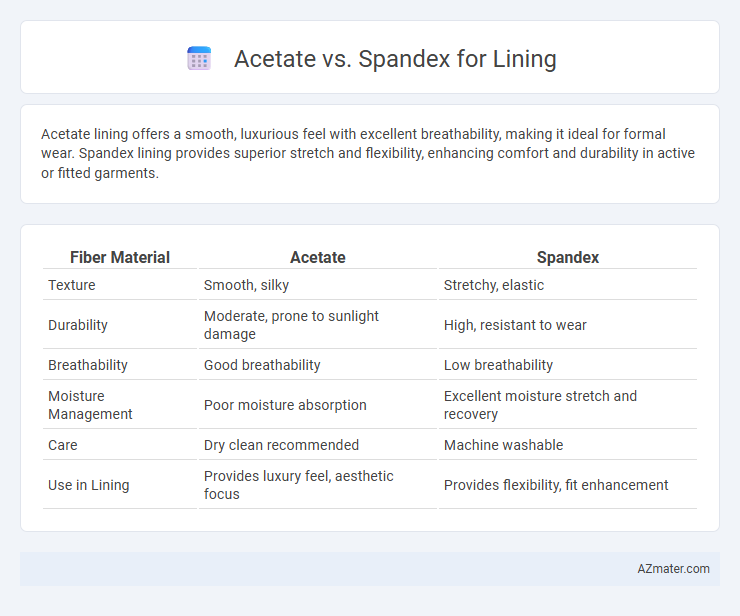Acetate lining offers a smooth, luxurious feel with excellent breathability, making it ideal for formal wear. Spandex lining provides superior stretch and flexibility, enhancing comfort and durability in active or fitted garments.
Table of Comparison
| Fiber Material | Acetate | Spandex |
|---|---|---|
| Texture | Smooth, silky | Stretchy, elastic |
| Durability | Moderate, prone to sunlight damage | High, resistant to wear |
| Breathability | Good breathability | Low breathability |
| Moisture Management | Poor moisture absorption | Excellent moisture stretch and recovery |
| Care | Dry clean recommended | Machine washable |
| Use in Lining | Provides luxury feel, aesthetic focus | Provides flexibility, fit enhancement |
Introduction to Acetate and Spandex Linings
Acetate linings offer a smooth, silky feel with excellent drape and breathability, making them ideal for lightweight garments and formal wear. Spandex linings provide superior stretch and recovery, enhancing comfort and flexibility in activewear and fitted clothing. Both materials contribute distinct functional benefits tailored to specific garment needs and performance requirements.
Key Differences Between Acetate and Spandex
Acetate is a semi-synthetic fiber known for its smooth, silky texture and excellent breathability, making it ideal for lining formal garments and lightweight clothing. Spandex, also called elastane, stands out for its exceptional stretch and recovery properties, providing enhanced flexibility and comfort in linings for activewear and fitted garments. The key differences between acetate and spandex lie in acetate's breathability and drape versus spandex's elasticity and durability in stretch applications.
Comfort and Breathability Comparison
Acetate linings offer a smooth, silky feel with moderate breathability, making them comfortable in cooler climates but less effective at moisture-wicking. Spandex linings provide superior stretch and flexibility, enhancing comfort during movement, while their synthetic fibers typically reduce breathability compared to natural materials. For optimal comfort and breathability, blends of acetate and spandex are often used to balance softness, stretch, and ventilation.
Durability and Longevity Analysis
Acetate linings offer a silky texture and vibrant sheen but tend to have lower durability, often showing signs of wear such as pilling and shrinking over time. Spandex linings provide exceptional stretch and resilience, maintaining shape and integrity through frequent use and washing. For garments requiring long-lasting performance, spandex blends outperform acetate by offering superior elasticity and resistance to abrasion, enhancing overall longevity.
Stretch and Flexibility Features
Acetate linings offer limited stretch and minimal flexibility, making them suitable for structured garments that require a smooth, crisp finish. Spandex linings provide exceptional elasticity and superior flexibility, enhancing comfort and allowing garments to move freely with the body. Choosing spandex is ideal for activewear or fitted clothing due to its high stretch recovery and durability.
Moisture Wicking and Absorbency
Acetate lining offers moderate moisture absorbency and provides a smooth, breathable feel but lacks advanced moisture-wicking properties. Spandex lining excels in stretch and flexibility, with limited absorbency but can be integrated with moisture-wicking fabrics to enhance sweat evaporation. Choosing acetate favors comfort with moderate absorbency, while spandex supports active wear needs when combined with high-performance moisture-wicking textiles.
Care and Maintenance Requirements
Acetate linings require gentle care, preferring dry cleaning to preserve their smooth texture and prevent damage from water and heat. Spandex linings offer greater durability and flexibility, allowing for machine washing on a gentle cycle with cold water, but should be air-dried to maintain elasticity. Proper care of both materials ensures longevity, with acetates demanding more delicate handling compared to the more resilient spandex.
Environmental Impact and Sustainability
Acetate linings, derived from cellulose acetate, offer better biodegradability and lower environmental impact due to their renewable plant-based origins compared to spandex, which is petroleum-based and non-biodegradable. The production of spandex involves toxic chemicals and high energy consumption, contributing to pollution and resource depletion. Sustainable choices prioritize acetate for its reduced carbon footprint and compostable properties, aligning with eco-friendly textile manufacturing goals.
Best Uses in Fashion and Apparel
Acetate linings are prized for their smooth, silky texture and excellent drape, making them ideal for formalwear and high-end garments that require a luxurious feel and sheen. Spandex linings provide superior stretch and recovery, enhancing comfort and flexibility in activewear, sportswear, and fitted apparel that demand mobility and shape retention. Choosing the right lining depends on the garment's purpose: acetate excels in elegance and breathability, while spandex is preferred for durability and stretch performance in dynamic designs.
Choosing the Right Lining: Acetate or Spandex?
Acetate lining offers a smooth, silky feel with excellent moisture-wicking properties, making it ideal for lightweight, breathable garments. Spandex lining provides superior stretch and flexibility, enhancing comfort and durability in activewear or fitted clothing. Selecting the right lining depends on the garment's purpose: acetate is best for elegance and breathability, while spandex excels in stretch and resilience.

Infographic: Acetate vs Spandex for Lining
 azmater.com
azmater.com